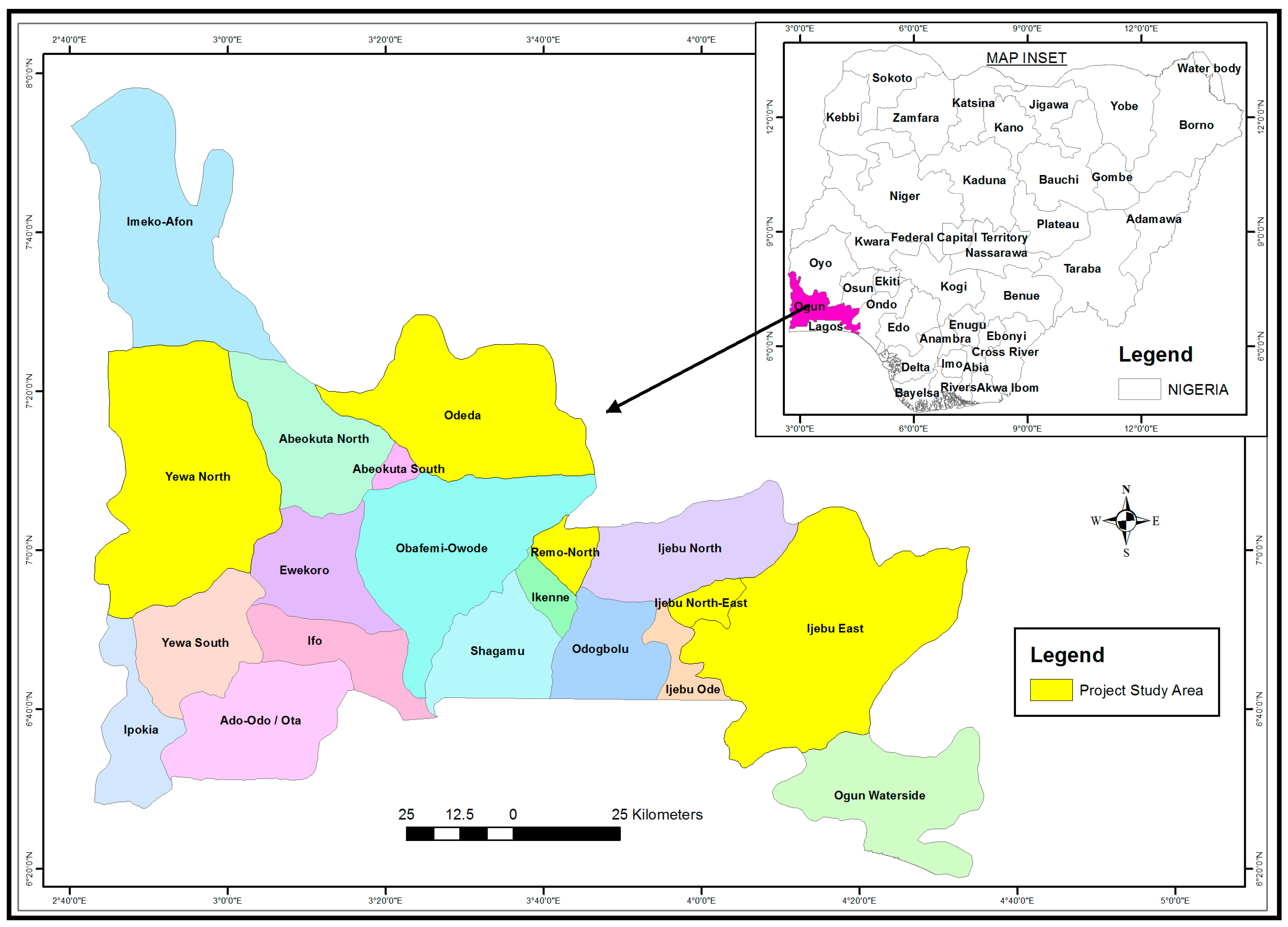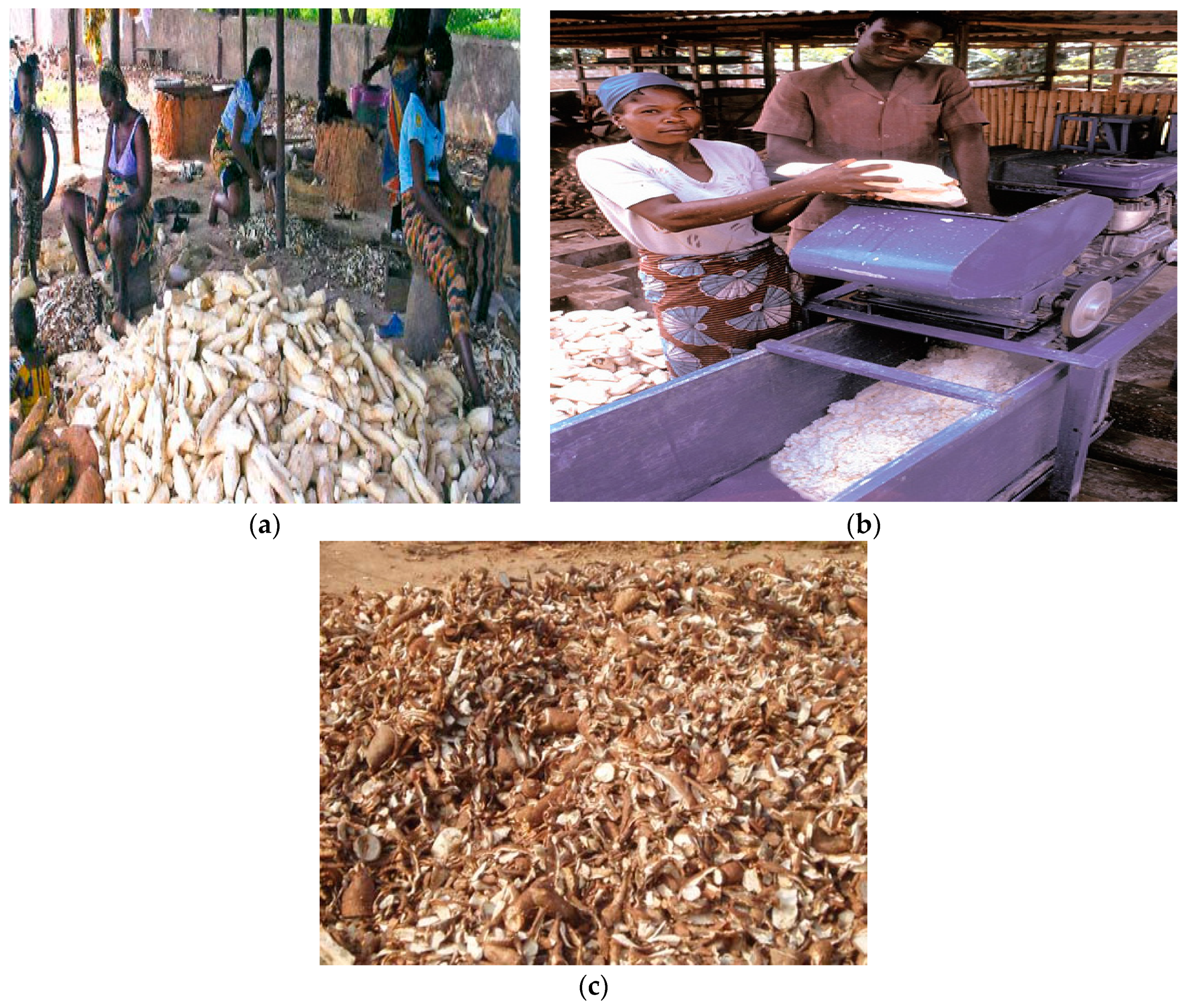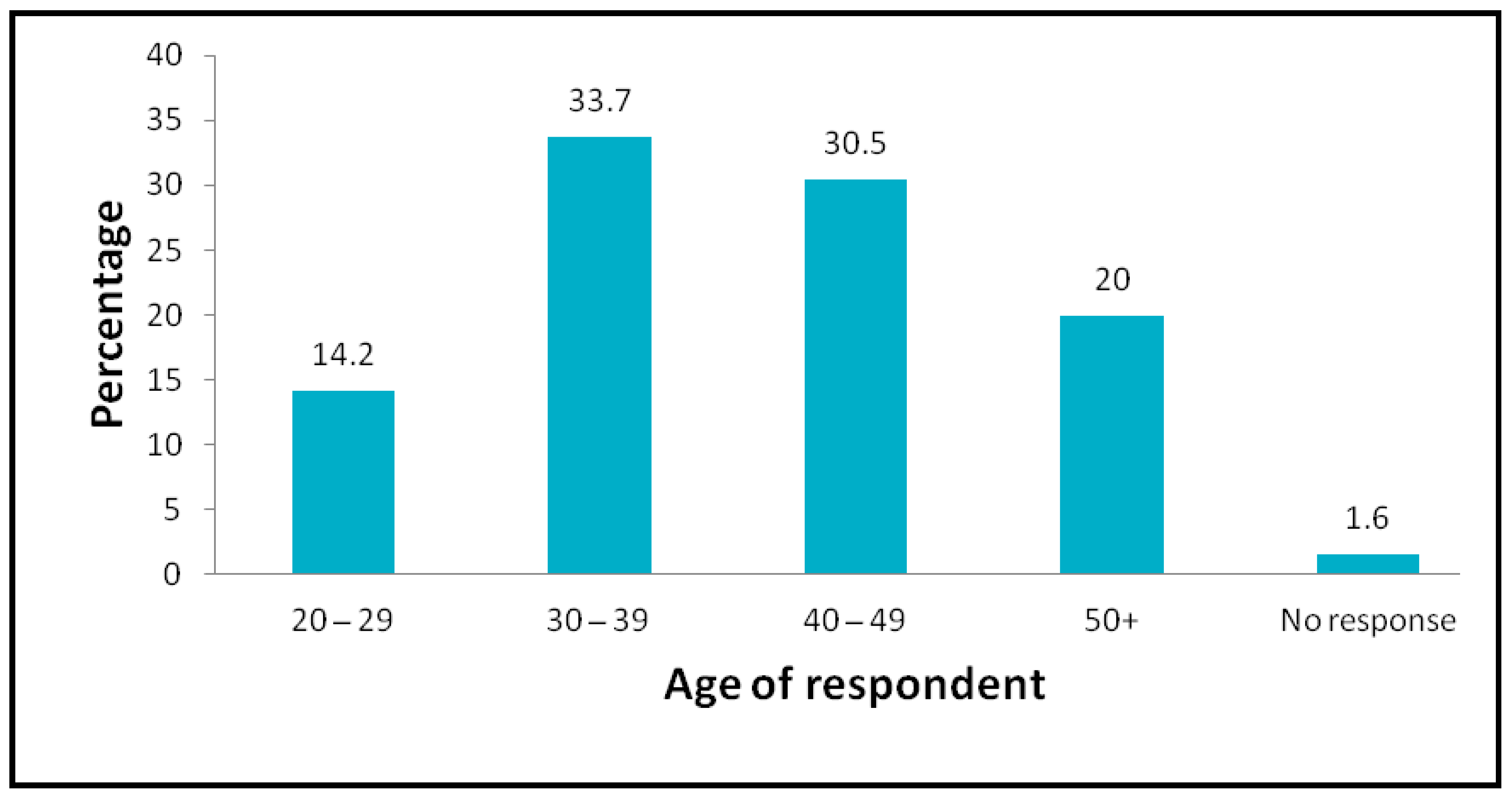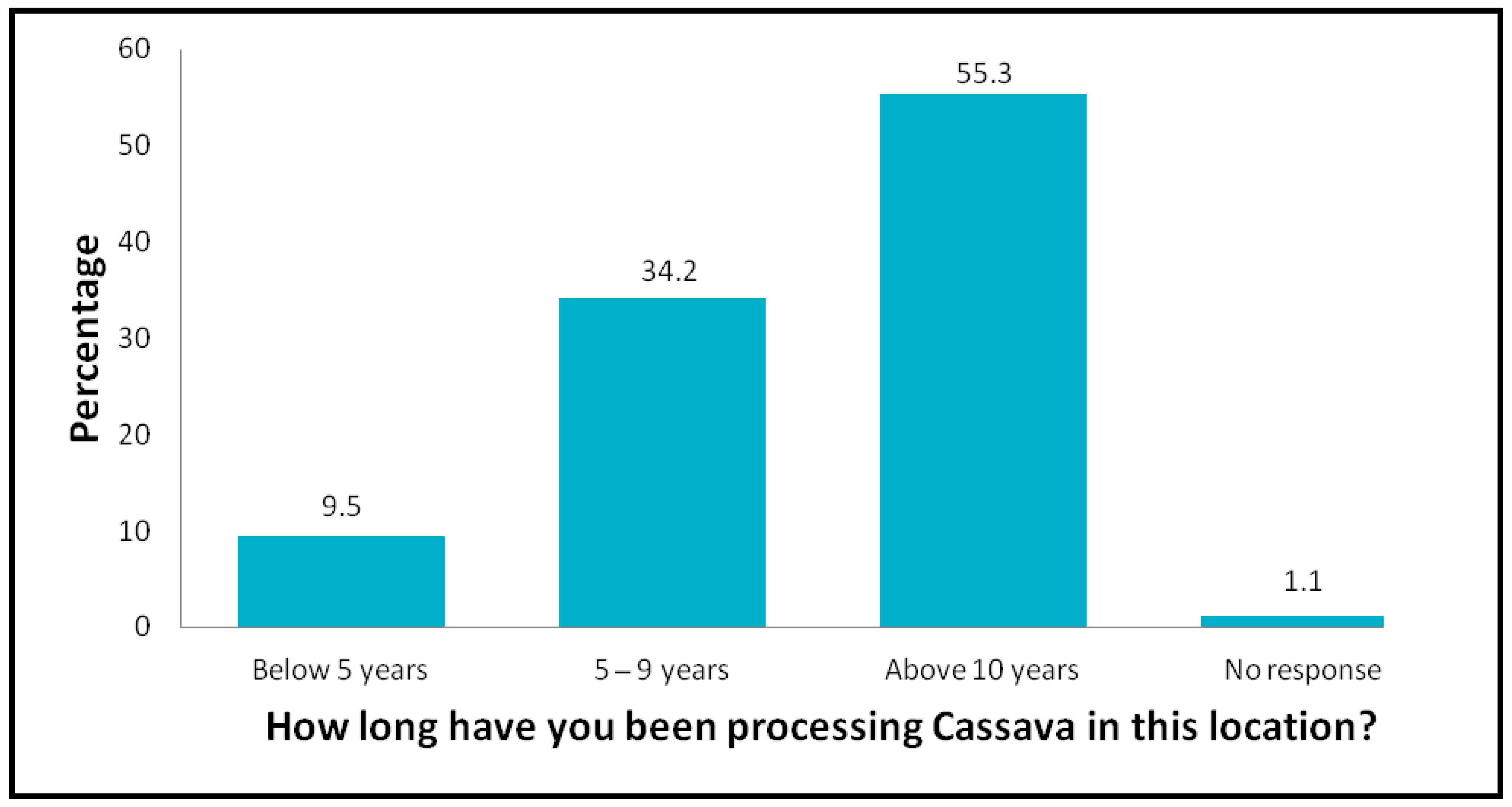Cassava Waste Management and Biogas Generation Potential in Selected Local Government Areas in Ogun State, Nigeria
Abstract
:1. Introduction
- find out the method of waste disposal that is adopted by cassava processors in the selected local government areas,
- find out what cassava residues are used for in the selected cassava-processing factories,
- find out the factors that influence processors’ willingness to pay for an improved waste management system, and
- investigate if cassava wastes generated in the selected local government areas have the potential for the generation of biofuel.
2. Materials and Methods
2.1. Sample Size and Sample Technique
2.2. Reliability of Instruments
3. Results and Discussion
Biogas Production Potential
4. Conclusions
5. Recommendations
- That proper waste disposal methods should be adopted by the cassava processors in Ogun State to minimize pollution and reduce health risks.
- There is a need for awareness of the income generation potential of cassava waste among the cassava processors in Ogun State.
- It is highly recommended that the waste water generated from cassava processing undergoes proper treatment before it is discharged.
- Based on the biogas generation potential of the cassava-processing factories in Ogun State, it is important that this resource be harnessed.
Author Contributions
Funding
Acknowledgements
Conflicts of Interest
References
- Asante-Pok, A. Analysis of Incentives and Disincentives for Cassava in Nigeria; FAO Technical Notes Series; FAO: Rome, Italy, 2013. [Google Scholar]
- Omilani, O.; Abass, A.; Okoruwa, V.O. Willingness to Pay for Value-Added Solid Waste Management System among Cassava Processors in Nigeria. 2015. Available online: www.tropentag.de/2015/proceedings/node515.html (accessed on 22 May 2018).
- Westby, A. Cassava Utilization, Storage and S mall-scale Processing. In Cassava Biology, Production and Utilization; Hillock, R., Thresh, J., Bellotti, A.C., Eds.; CABI Publishing: Wallingford, UK, 2008. [Google Scholar]
- Olukanni, D.O.; Agunwamba, J.C.; Abalogu, R.U. Interaction between suspended and settled solid particles in cassava waste water. Sci. Res. Essay 2013, 8, 414–424. [Google Scholar]
- Pandey, A.; Soccol, C.R.; Nigam, P.; Soccol, V.T.; Vandenberghe, L.P.; Mohan, R. Biotechnological potential of agro-industrial residues. II: Cassava bagasse. Bioresour. Technol. 2000, 74, 81–87. [Google Scholar] [CrossRef]
- Barros, F.; Ana, P.D.; Júnio, C.; Gláucia, M. Potential Uses of Cassava Wastewater in Biotechnological Processes. In Agriculture Issues and Policies: Cassava Farming, Uses and Economic Impact; Pace, C.M., Ed.; NOVA Science Publishers Inc.: New York, NY, USA, 2012; Chapter 2; pp. 33–54. ISBN 978-1-61209655-1. [Google Scholar]
- Osunbitan, J.A. Short term effects of Cassava processing waste water on some chemical properties of loamy sand soil in Nigeria. J. Soil Sci. Environ. Manag. 2012, 3, 164–171. [Google Scholar]
- FAO (Food and Agricultural Organization) of United Nations. Annual Statistics; FAO: Rome, Italy, 2004. [Google Scholar]
- Eze, J.I. Converting Cassava (Manihot spp) Waste from Gari Processing Industry to Energy and Bio-Fertilizer. Glob. J. Res. Eng. 2010, 10, 113–117. [Google Scholar]
- Tonukari, N.J.; Ezedom, T.; Enuma, C.C.; Sakpa, S.O.; Avwioroko, O.J.; Eraga, L.; Odiyoma, E. White Gold: Cassava as an Industrial Base. Am. J. Plant Sci. 2015, 6, 972–979. [Google Scholar] [CrossRef]
- Dada, A.D.; Afolabi, O.O.; Siyanbola, W.O. Harnessing Science and Technology for Cassava Productivity and Food Security in Nigeria. In Proceedings of the Portland International Conference on Management of Engineering & Technology, Portland, OR, USA, 2–6 August 2009. [Google Scholar]
- Aro, S.O.; Aletor, V.A.; Tewe, O.O.; Agbede, J.O. Nutritional potentials of cassava tuber wastes: A case study of a cassava starch processing factory in south-western Nigeria. Livest. Res. Rural Dev. 2010, 22, 1–11. [Google Scholar]
- Sackey, I.S.; Bani, R.J. Survey of waste management practices in cassava processing to gari in selected districts of Ghana. J. Food Agric. Environ. 2007, 5, 325–328. [Google Scholar]
- Oparaku, N.F.; Ofomatah, A.C.; Okoroigwe, E.C. Biodigestion of cassava peels blended with pig dung for methane generation. Afr. J. Biotechnol. 2013, 12, 5956–5961. [Google Scholar] [CrossRef]
- Olukanni, D.O.; Aremu, O.D. Provisional Evaluation of Composting as Priority Option for Sustainable Waste Management in South-West Nigeria. Pollution 2017, 3, 417–428. [Google Scholar]
- Oresanya, O.O.; Olukanni, D.O. The evolution of solid waste management in Lagos State, Nigeria. A glance at the world. Waste Manag. 2017, 66, 1–3. [Google Scholar]
- Echebiri, R.N.; Edaba, M.E. Production and Utilization of Cassava in Nigeria: Prospects for Food Security and Infant Nutrition. Prod. Agric. Technol. 2008, 4, 38–52. [Google Scholar]
- Onu, B.; Surendran, S.S.; Price, T. Impact of Inadequate Urban Planning on Municipal Solid Waste Management in the Niger Delta Region of Nigeria. J. Sustain. Dev. 2014, 7, 27–45. [Google Scholar] [CrossRef]
- Popescu, A.M.; Alecxandrina, D.; Popescu, T. The impact of gender difference at Romanian small and medium enterprises (SME) management level, analyzed by organizational citizenship behavior. Eur. J. Hum. Soc. Sci. 2013, 27, 1390–1406. [Google Scholar] [CrossRef]
- Adebayo, K.; Anyanwu, A.C.; Osiyale, A.O. Perception of Environmental Issues by Cassava Processors in Ogun State, Nigeria—Implications for Environmental Extension Education. J. Ext. Syst. 2003, 19, 103–112. [Google Scholar]
- Coker, A.; Achi, C.; Sridhar, M.K. Utilization of Cassava Processing Waste As A Viable And Sustainable Strategy For Meeting Cassava Processing Energy Needs: Case Study From Ibadan City, Nigeria. In Proceedings of the Thirtieth International Conference on Solid Waste Technology and Management, Philadelphia, PA, USA, 3–6 April 2010. [Google Scholar]
- Niringiye, A.; Omortor G., D. Determinants of Willingness to Pay for Solid Waste Management in Kampala City. Curr. Res. J. Econ. Theory 2010, 2, 119–122. [Google Scholar]
- Olukanni, D.O.; Adeleke, J.O.; Aremu, D.D. A Review of Local Factors affecting Solid Waste Collection in Nigeria. Pollution 2016, 2, 339–356. [Google Scholar]
- Awunyo-Vitor, D.; Ishak, S.; Jasaw, G.S. Urban Households’ Willingness to Pay for Improved Solid Waste Disposal Services in Kumasi Metropolis, Ghana. Urban Stud. Res. 2013, 2013, 2–8. [Google Scholar] [CrossRef]
- Oyegbami, A.; Oboh, G.; Omueti, O. Cassava processors’ awareness of occupational and environmental hazards associated with cassava processing in South-Western Nigeria. Afr. J. Food Agric. Dev. 2010, 10, 2177–2186. [Google Scholar]
- Wantanee, A.; Rodtong, S. Laboratory Scale Experiments for Biogas Production from Cassava Tubers. Presented at the Joint International Conference on “Sustainable Energy and Environment”, Hua Hin, Thailand, 1–3 December 2004. [Google Scholar]








| Major Type of Solid Waste Produced from the Cassava-Processing Operation | Percent | Valid Percent | Cumulative Percent | |
|---|---|---|---|---|
| Valid | Cassava peel and cassava pomace | 86.8 | 86.8 | 86.8 |
| Cassava peel | 10.5 | 10.5 | 97.3 | |
| Cassava pomace | 1.6 | 1.6 | 98.9 | |
| No response | 1.1 | 1.1 | 100.0 | |
| Total | 100.0 | 100.0 | ||
| How are the cassava solid wastes disposed? | ||||
| Valid | Cassava waste dump site | 90.5 | 90.5 | 90.5 |
| Burnt near the factory | 4.2 | 4.2 | 94.7 | |
| No response | 5.3 | 5.3 | 100.0 | |
| Total | 100.0 | 100.0 | ||
| What do you use cassava residues for? | ||||
| Valid | Animal feeds | 97.3 | 97.3 | 97.3 |
| Fertilizer | 1.6 | 1.6 | 98.9 | |
| No response | 1.1 | 1.1 | 100.0 | |
| Total | 100.0 | 100.0 | ||
| Willingness to pay for an improved waste management system | ||||
| Valid | Yes | 74.7 {F = 87.3; M = 12.7} | 74.7 | 74.7 |
| No | 24.2 {F = 17.4; M = 82.6} | 24.2 | 98.9 | |
| No response | 1.1 | 1.1 | 100.0 | |
| Total | 100.0 | 100.0 | ||
| Local Government (5 Factories) | Yewa North | Odeda | Ijebu North East | Ijebu East | Remo North |
|---|---|---|---|---|---|
| Cassava production per day (kg) | 7500 | 10,000 | 12,000 | 8750 | 7500 |
| Quantity of cassava peel per day (kg) | 2250 | 3000 | 3600 | 2625 | 2250 |
| Quantity of biogas (L/day) | (2250 kg × 497.01) = 1,118.273 | (3000 kg × 497.01) = 1,491.030 | (3600 kg × 497.01) = 1,789.236 | (2625 kg × 497.01) = 1,304.651 | (2250 kg × 497.01) = 1,118.273 |
© 2018 by the authors. Licensee MDPI, Basel, Switzerland. This article is an open access article distributed under the terms and conditions of the Creative Commons Attribution (CC BY) license (http://creativecommons.org/licenses/by/4.0/).
Share and Cite
Olukanni, D.O.; Olatunji, T.O. Cassava Waste Management and Biogas Generation Potential in Selected Local Government Areas in Ogun State, Nigeria. Recycling 2018, 3, 58. https://doi.org/10.3390/recycling3040058
Olukanni DO, Olatunji TO. Cassava Waste Management and Biogas Generation Potential in Selected Local Government Areas in Ogun State, Nigeria. Recycling. 2018; 3(4):58. https://doi.org/10.3390/recycling3040058
Chicago/Turabian StyleOlukanni, David O., and Tope O. Olatunji. 2018. "Cassava Waste Management and Biogas Generation Potential in Selected Local Government Areas in Ogun State, Nigeria" Recycling 3, no. 4: 58. https://doi.org/10.3390/recycling3040058
APA StyleOlukanni, D. O., & Olatunji, T. O. (2018). Cassava Waste Management and Biogas Generation Potential in Selected Local Government Areas in Ogun State, Nigeria. Recycling, 3(4), 58. https://doi.org/10.3390/recycling3040058





